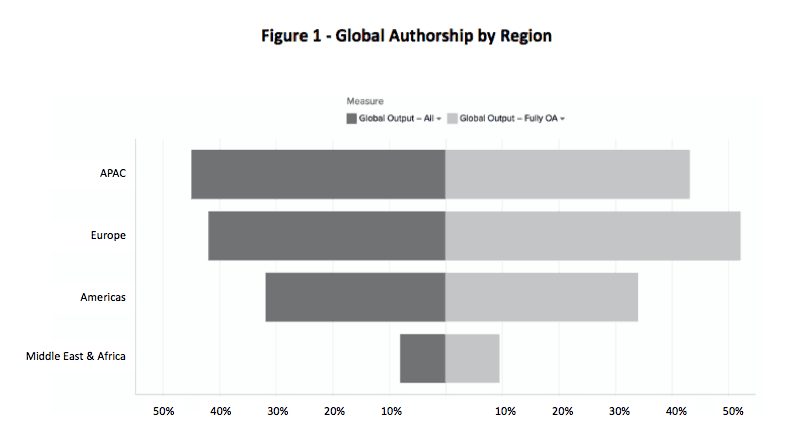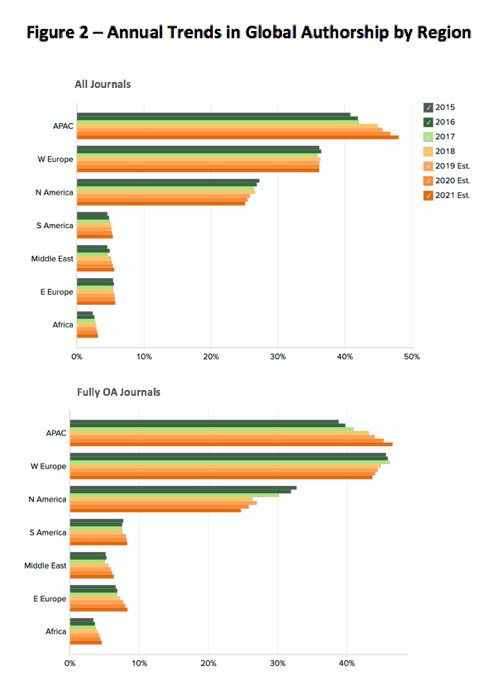As part of our annual sizing update at the end of 2019, we added significantly more information about regional publishing adoption to our market analysis tools. This month we examine patterns in global output and find some interesting nuances in the shifting balances between regions.
A quick note on multi-author papers
When analyzing geographic uptake, we need a way of handling papers which have multiple authors from different regions. In these cases, papers are counted once for each region. For example, a paper with one author from the US and one from the UK would be counted twice – once for each country. This means that total percentages per region add up to more than 100%. This may seem like double-counting, but keeping the overlap is useful to understand how regions affect things globally. For example, Plan S specifies that if any ONE author is funded by a Plan S-compliant funder, then the ENTIRE paper must be published under a Plan S-compliant policy. So, in our example, we could reasonably consider our UK author to have 100% influence over policy.
Global Authorship
The following figure analyzes the spread of output across major regions, comparing papers published in all journals with those published in fully OA journals.

Sources: SCImago JR, ISO, US National Science Foundation, Delta Think analysis. © 2020 Delta Think, Inc. All rights reserved. [SCImago. (2007). SJR — SCImago Journal & Country Rank. Retrieved July 2019, from http://www.scimagojr.com]
- Authors from Asia-Pacific (APAC) account for just under 45% of papers, with Europe a close second and the Americas third. (Total papers in this model amount to just under 2.4 million.)
- However, Europe leads in authorship in fully OA journals, covering 52% of output compared with APAC’s 43%. (The model covers just over 500,000 papers in fully OA journals.)
Trends
We can further analyze how numbers are changing over time. The figure below shows this, drilling into a little more detail about specific regions.

Sources: SCImago JR, ISO, US National Science Foundation, Delta Think analysis. © 2020 Delta Think, Inc. All rights reserved. [SCImago. (2007). SJR — SCImago Journal & Country Rank. Retrieved July 2019, from http://www.scimagojr.com]
- The top chart shows publications in all journals. Each color represents a different year. We can see that APAC’s share of output is growing, while Western Europe is flatlining and North America lessening.
- Share of output in fully OA journals (the bottom chart) shows a slightly different picture. APAC is growing, but in this case, Western Europe’s share is declining, and North America’s share is shrinking even faster.
- Smaller economies are growing their share of fully OA faster than they are growing their share of overall output, albeit from lower bases.
Conclusions
By measuring share of output and including overlap between multi-author papers, we can analyze how the “influence” of authors from different regions is changing. As shown above, data confirms the increase in APAC output and the static or decreasing trends in Western Europe and North America, respectively.
The story is much more nuanced when you drill into each country’s contributions. For example, China accounts for a bit less than half (48%) of the APAC region’s influence. While countries such as South Korea, Japan, India, and Australia account for single-digit percentages each, together they are moving the needle, accounting for almost 38% of APAC’s total output.
Finally, we attach a minor warning to some of the data. We run forecasts by trending historical data dating back to 2009 (charts above include data from 2015 forward). On the whole this allows us to get to long-term trends, but history is not always an accurate predictor of the future. Western Europe is notable: its share of fully OA output fell between 2009 and 2014, then increased from 2015 to 2017, then fell back again in 2018. So, its long-term trend is downwards, but recent developments may yet give it a boost.
Subscribers to Delta Think’s Open Access Data & Analytics Tool can drill into these details and pull out charts similar to the ones above at a per-country, regional, or custom-grouping level (for example, to examine Plan S countries). Please contact us for more information.
Wishing all our readers a Happy New Year!

TOP HEADLINES
Dutch research institutions and Elsevier reach framework agreement – December 19, 2019
“The Association of Universities in the Netherlands (VSNU), The Netherlands Federation of University Medical Centres (NFU), The Dutch Research Council (NWO), and the global information and analytics business Elsevier, have reached a framework agreement. NWO President Stan Gielen said, ‘This agreement is in accordance with Plan S and is a huge step towards 100 percent open access and therefore a major breakthrough for open science in the Netherlands.'”
Frontiers and medRxiv integration announced – December 19, 2019
“Frontiers is pleased to announce that from December 19th 2019, authors can directly submit their archived manuscripts to its publishing platform via the medical pre-print site ‘medRxiv’. medRxiv is the third platform of this type to be integrated with Frontiers submission system.”
SPARC Statement on Rumored New White House Open Access Policy – December 19, 2019
A statement by Heather Joseph, Executive Director of SPARC (the Scholarly Publishing and Academic Resources Coalition), on press reports of an impending new White House Open Access Policy.
Coalition of 135+ Scientific Research and Publishing Organizations Sends Letter to Administration – December 18, 2019
“In a new major letter signaling deep concern, more than 135 organizations – representing publishers in scientific and medical societies, global companies, and the U.S. Chamber of Commerce – have expressed their strong opposition to a proposed Administration policy that would mandate immediate free distribution of peer-reviewed journal articles reporting on federally funded research.”
Alternative conditions needed in order for cOAlition S’s proposal for Transformative Journals to succeed – December 17, 2019
“As the largest OA publisher, and the publisher that first floated the idea of Transformative Journals, Springer Nature is appealing to cOAlition S in an open letter not to lose the opportunity Transformative Journals offer to speed up the transition to OA. Unless changes are made to the conditions being proposed the publisher believes it would be unable to commit to its journals participating.”
cOAlition S reaction to Springer Nature’s Open Letter on Transformative Journals – December 17, 2019
cOAlition S has responded to Springer Nature’s Open Letter on Transformative Journals.
Jisc and IOP Publishing secure new transitional open access agreement for UK universities – December 9, 2019
“Researchers at up to 58 UK universities will soon benefit from a new open access (OA) ‘read and publish’ agreement between Jisc and IOP Publishing (IOPP), a pioneer in open access physics publishing. The four-year agreement begins on January 1, 2020. It enables unlimited open access publishing for affiliated corresponding authors in 44 of IOPP’s subscription journals, without barriers or charges to authors.”
Addendum to the cOAlition S Guidance on the Implementation of Plan S – November 27, 2019
“cOAlition S endorse a number of strategies to encourage subscription publishers to transition to Open Access. These approaches are referred to as ’transformative arrangements’ and include transformative agreements, transformative model agreements and transformative journals.”
OA JOURNAL LAUNCHES
December 12, 2019 | Nano Express – a new open access journal from IOP Publishing | “IOP Publishing is announcing Nano Express, a new open access addition to its materials science portfolio, which will compliment Nanotechnology and Nano Futures as a trio of connected titles dedicated to nanoscience.” |
December 10, 2019 | University of California press launches Media+Environmentjournal using Scholastica | “Scholastica is pleased to announce the launch of a new University of California Press journal using its platform, Media+Environmemt. The new journal will explore the nexus between digital media platforms and environments as media…is both free to read and free to publish in and uses a CC BY 4.0 license for all articles.” |
December 10, 2019 | “IOP Publishing is introducing IOP SciNotes, a new peer-reviewed, open access journal that will enable researchers across the physical and environmental sciences to publish shorter research results and other related outputs, which may not be suited to the traditional full-length journal article format.” | |
December 3, 2019 | “We are delighted to announce that Natures Sciences Sociétés (NSS) will be published in open access from January 2020. The journal will be hosted and produced by EDP Sciences, which is actively supporting the transition of journals to open access. Articles will be freely accessible and published under a Creative Commons (CC-BY) licence, thereby allowing authors to retain copyright.” | |
November 19, 2019 | “The Royal Society of Chemistry announces RSC Chemical Biology – a new gold open access journal for exceptionally significant findings in chemical biology. Article publication charges for the journal are waived until mid-2022, meaning it will be free to read and free to publish in for the first two years.” |

